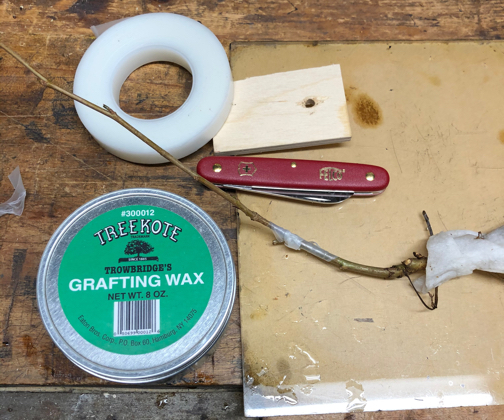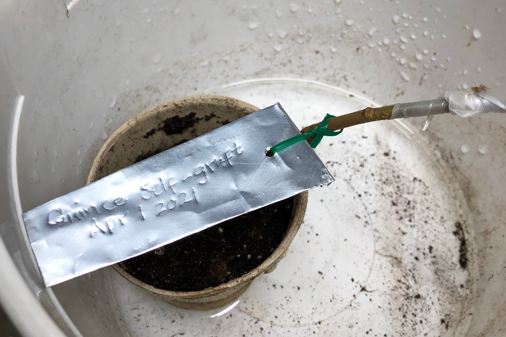My big project for this spring is to learn how to graft apple trees. The biggest reason is that one of our apple trees in Casco is some unidentified heirloom variety. All of the apple trees that were there when we bought the place have been doing poorly for the last several years. We actually lost one completely, the red delicious, a year ago. The macintosh produced some good fruit in 2019, but not much. We thought the problem was lack of rain, but found out recently that dwarf apple trees have a life expectancy of around thirty years — which is about how old all of these are. The only way to still have apples of the unidentified heirloom one is to graft a scion of it (that’s the technical term for a snip of a tree you want to propagate!) onto a new root. So I ordered some scions of other heirloom varieties and twenty pieces of rootstock from Fedco Trees (so I can practice on other stuff, and get some more heirloom varieties going if it works) and signed up for a zoom class on grafting from MOFGA, Maine Organic Farmers and Gardners Association. Also, I’ve watched several You Tube videos about grafting apple trees. I’m psyched, but don’t know what kind of results to expect.
When I was in college I did something right in a biology lab, preparing a slide of Drosophila (fruit fly) salivary gland chromosomes. It took some care working with really small stuff under a microscope, and it was enough to make the professor think I was good at that kind of thing. Grafting seems to require a similar level of care and respect for the biology of the material, so I’m holding onto that memory to maintain some confidence.
I wanted to try grafting out before I get all the apple material, both to see what the plant material is like and to become familiar with the tools and process. We have a flowering quince bush in Newton on the edge of the driveway which sends up more stems from the ground than we want (in fact, we have to cut dozens off every year to keep the area clear for getting out of the car). Quince is closely related to apple — you would guess from cutting a quince fruit across the middle that it’s related to apple and pear, and you’d be right — so I thought that digging up a shoot for rootstock and cutting a scion off the top would be an easy way to get material similar to apple to try out. I dug a shoot up a couple of weeks ago and stuck it in a bucket of water to keep the root from drying out. Earlier this week I was pleased to see a few leaves starting at the top of the shoot, so I knew the root was supplying water where it needed to; so today I cut off a scion, gathered my grafting supplies, and tried. Here’s what it looked like:

That’s a roll of tape at the top; it’s special extra stretchy plastic that will hold the graft together, keep it from drying out, and protect it from infection, but allow the tree to grow as much as it needs to. The little piece of wood with the hole is to protect my fingers from the knife below it — you stick each piece of tree through the hole, slice it off on a long taper, and cut back through the middle of the stick towards yourself or rather towards that piece of wood on the other side of which you are holding the other end of the piece of tree. The treekote wax is really sticky stuff which will keep the cut end of the scion from drying out; you only want two buds on the scion because there’s not going to be much water getting through the graft at first, not enough to support a lot of buds, and you don’t want to lose any of it by evaporation. Part of the exercise today was just getting the feel of the treekote, the tape, and the knife. I can keep an eye on this and if the buds open and leaf out I’ll know that I have a basic understanding of the process; plus a flowering quince to plant in Casco. And, I’ll think seriously about cutting scions of the quince trees in Casco to graft onto other shoots of this rootstock.

I cut several aluminum soft drink cans up to make metal tags to label the grafted trees when I have them. There’s no way to tell what variety is what unless you have a label, and you want to have a label that will last for years in the weather. Several years ago I bought a few metal labels at a nursery; they had cardboard backing to support the metal around the writing, and that’s lots better than what I did, but this should work.
- * * * * * * * * * *
We got an order from Imperfect Foods today that was really imperfect — Arlene knew right away that something was off because it was two or three times as heavy as our previous orders. There were also things right on top that we never order. That’s because it was for someone else! There was a label with a name on it, and an address 70 house numbers away (that works out to about a dozen houses away the way this street goes). We looked up the name on whitepages, left a phone message, and walked down the street to see if anyone was there — not carrying 25 or 30 pounds of imperfect food. They were home, and they had two cartons from Imperfect that weren’t ours nor for them either, but were addressed to Hammond Pond Parkway. I don’t know what they ended up doing with those, but they did drive to our house and pick up their order.